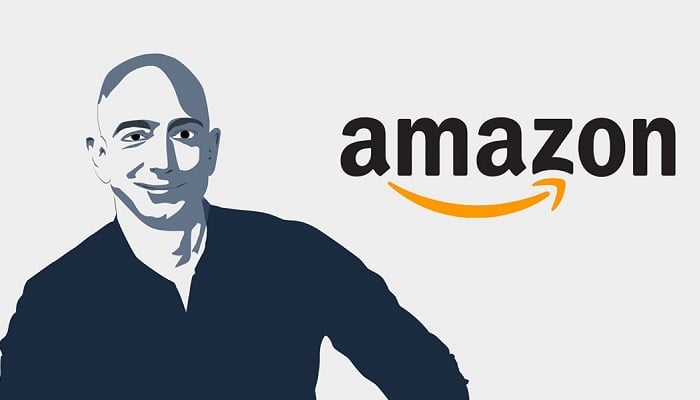In light of the fact that this global commerce behemoth expands both geographically and in terms of the goods and services it offers, defining the Amazon business model might be a bit of a puzzle. To give you an indication of the enormity of the company we’re talking about, Amazon may have increased its income by approximately a million dollars in the time it takes you to read this short article.
An overview of Amazon’s history
The first step in creating a “online everything store” was taken in 1994 by Jeff Bezos, a former Wall Street hedge fund executive and visionary who was already aware of the potential of the internet and e-commerce platforms. Yes, he knew from the start that this was Amazon’s goal. He first considered calling the business “Cadabra” (after the magic word abracadabra). Todd Tarbert, his attorney, cautioned him that the name could come off as a little mysterious. In addition, particularly over the phone, it sounded like “cadaver.”
The choice of the product to be offered on the e-commerce site would come after the new name had been made. Bezos concluded that selling books would be the most sensible course of action. Amazon.com achieved 180,000 accounts in its first year, defying financial journalists and experts who just weren’t able to predict the expansion of the internet the way Bezos did. Amazon.com went public in May 1997, listing for $54 million on the NASDAQ.
There were 1 million customers and $148 million in sales by the end of the same year (which would grow to $610 million the following year). The business quickly grew and started offering toys, games, houseware, electronics, films, music, and more. Additionally, its tailored suggestion tools and user evaluations were what drew buyers, creating a consumer community. In 2000, Amazon made it possible for small businesses and individuals to sell their products on the website.
The debut of Amazon Web Services (AWS) two years later proved what Bezos had said from the beginning: that Amazon was a technological business rather than a retailer. Since then, AWS has expanded to include its Simple Storage Service for renting out data storage, Elastic Compute Cloud for renting out computer processing capacity, and Internet statistics for developers and marketers. In 2007, Kindle e-readers first became available, boosting the e-book industry.
The business introduced Amazon Encore, its first publishing division, in 2009 so that people could also self-publish their own e-books. It would change into Amazon Publishing two years later with the intention of creating its own publications. Amazon transitioned from being a bookshop to a “everything store” to a major force in global e-commerce. However, the brand didn’t finish there and has almost endless potential. Perhaps the company’s minimal profit margin on every item or service it provides is what draws customers in.
The customer may feel secure knowing that Amazon will always provide a fair and competitive pricing across all industries and goods. Additionally, it is helpful for sellers who utilize the multi-sided platform to know that they can simply exhibit their items on the website and do business on various continents of the world. Amazon is now acknowledged as the biggest retailer in the globe, and for this company, the sky seems to be the limit.
Owners of Amazon
Since Amazon is a publicly listed business, both institutional and private investors control it. The company’s creator, Jeff Bezos, still owns a sizable portion of it (about 10%), making him one of the most powerful shareholders. But in July 2021, Bezos resigned as CEO to take the Executive Chairman post, leaving Andy Jassy to serve as president and CEO in the present. Amazon is the official name of the holding group, in contrast to Google x Alphabet and Facebook x Meta connections, which cover all of its emerging services, including Amazon Music, Amazon Prime Video, Kindle and Alexa devices, Amazon Web Services (AWS), among many others.
The Mission Statement of Amazon
The four guiding principles of Amazon are: obsessing on the customer rather than the competition, being passionate about invention, being dedicated to operational excellence, and having a long-term perspective. Amazon aspires to be the planet’s most customer-focused business, best employer, and safest workplace.
How Amazon generates income
We need to examine each of the several businesses that fall under this large corporate structure in order to comprehend how Amazon generates revenue. The company’s operations have been effective in assisting it in achieving year over year profitability, which has propelled its expansion. As follows:
Amazon Marketplace: The company’s initial source of income, Amazon.com, generates more than 42% of its total revenue ($220 billion of the $513.98 billion it expects to generate from its online businesses in 2022). An extra $117.71 billion in income was generated by third-party vendors. In essence, Amazon charges its merchants a price to market and advertise their goods;
The success of Amazon’s subscription business model, Prime, has been largely dependent on it. Subscribers may access the platform’s movie and music streaming library, get free two-day delivery, have unlimited picture storage, etc. for a monthly charge. Currently, Prime has more than 150 million subscribers;
Amazon Web Services is a full IT infrastructure platform with affordable services that businesses, organizations, and institutions from all over the globe use. Despite not being the primary source of income, it is unquestionably the most lucrative;
Users may purchase, browse, and download books, periodicals, and newspapers from the Kindle Store using Amazon’s e-reading service, the Kindle. Amazon makes most of its money from the Prime membership plan rather than from the Kindle device. Additionally, the site enables independent writers to publish their e-books and info goods while deducting anywhere between 30 and 70% of royalties from purchases;
Amazon Patents: The firm has around 17,600 patents, many of which have been licensed by other businesses. They received roughly 2,051 patents from the USPTO alone in 2022; Amazon Advertising: The Amazon Ad platform provides sponsored videos and adverts. Due to the audience’s pre-existing intent to purchase, it is an extremely effective marketing medium.
Business Model Canvas for Amazon
Customer Segments on Amazon
The three main categories of Amazon’s client base are sellers, purchasers, and developers.
All businesses who utilize Amazon’s e-commerce platform to market and sell their goods to the company’s large customer base are sellers.
All members of the Amazon Web Services (AWS) community are developers. AWS is Amazon’s cloud computing platform. They have partners and clients “across almost every industry and of every size, including startups, enterprises, and public sector organizations,” according to the company’s website.
And the purchasers are the millions of individuals who use Amazon’s platforms to buy goods and services across the globe. Amazon keeps track of its consumers based on their interests, interactions, and personal data (including age, gender, location, and language, among other things).
Value Propositions of Amazon
Low prices, quick delivery, and a large assortment of goods are the three value propositions on which Jeff Bezos bases Amazon’s business strategy. The audience is aware that they can access the product catalog of the biggest retailer in the world with just the aid of a device connected to the internet, at a reasonable price, and with a swift, secure, and dependable delivery service, making convenience Amazon’s greatest value proposition.
Channels on Amazon
Without a doubt, its biggest and most significant outlet is the Amazon website. The company’s app, Amazon Prime (its streaming, entertainment, and subscription platform), and its affiliate program are other significant avenues. As an online business, it mostly uses digital marketing techniques including email marketing, sponsored articles, and adverts. In all, the business spent more than $20 billion on media in 2022.
Customer Relationships at Amazon
Without a question, maintaining a positive and long-lasting connection with its consumers is Amazon’s main priority. They keep a number of avenues of communication available with their customers as a result, including reviews and comments on the site, phone, online chat, and email contact. Additionally, they often provide comments within a short period of time.

Key Resources on Amazon
The technological infrastructure of Amazon is without a doubt “the one” Key Resource, and it must be extensive and extremely secure in order to keep the entire chain operating without disruption or losses (back in 2013, Amazon was down for about 40 minutes, which cost the company more than US$ 5 million in lost sales). Other than that, the company’s physical facilities, including its offices, warehouses, supply chain, and automation, are also important resources. Of course, Amazon requires human resources in order to ensure that its designers, engineers, developers, etc. are A-players.

Major Activities of Amazon
The creation, upkeep, and growth of Amazon’s enormous platform are its primary operations. As a result, the company makes investments in creating and managing its websites and apps, managing its entire supply chain, managing storage and logistics, protecting information on all platforms (such as e-commerce, streaming, cloud computing, etc.), creating movies, TV shows, and other content for its video platform, and marketing each of its goods and services.
Key Partners of Amazon
The main associates of Amazon are:
Sellers: As Amazon’s primary source of income, they are unquestionably the most significant brand partners. There are around 8 million in the whole globe, which ensures that more than half of the business’s income;
Bloggers who are affiliates get a commission for any sales generated by their recommendations. In addition to aiding in sales, they increase platform traffic;
Developers: Also known as the AWS segment’s partners, they consist of “tens of thousands of independent software vendors (ISVs) who adapt their technology to work on AWS” and “thousands of systems integrators who specialize in AWS services” according to Amazon;
Independent writers that use Kindle Direct Publishing to publish their works are considered content producers.
Subsidiaries: These firms provide storage facilities, retail establishments, and systems in addition to brands and goods created by Amazon, such Amazon Essentials, Amazon Elements, Amazon Elements, Kindle, Alexa, and so on.
The Cost Structure of Amazon
The cost structure of Amazon includes all costs associated with maintaining its physical spaces, such as fulfillment centers, sortation centers, and delivery stations, as well as its entire IT infrastructure, customer service center, software development and maintenance, information security, and marketing.





